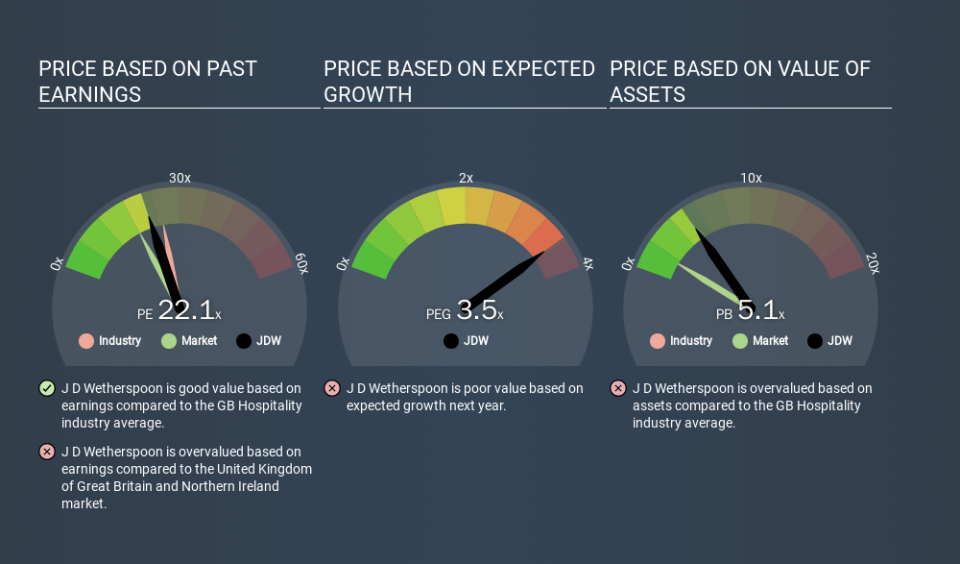Does J D Wetherspoon plc's (LON:JDW) P/E Ratio Signal A Buying Opportunity?

The goal of this article is to teach you how to use price to earnings ratios (P/E ratios). To keep it practical, we'll show how J D Wetherspoon plc's (LON:JDW) P/E ratio could help you assess the value on offer. J D Wetherspoon has a P/E ratio of 22.06, based on the last twelve months. In other words, at today's prices, investors are paying £22.06 for every £1 in prior year profit.
Check out our latest analysis for J D Wetherspoon
How Do You Calculate A P/E Ratio?
The formula for price to earnings is:
Price to Earnings Ratio = Price per Share ÷ Earnings per Share (EPS)
Or for J D Wetherspoon:
P/E of 22.06 = GBP15.57 ÷ GBP0.71 (Based on the trailing twelve months to July 2019.)
Is A High P/E Ratio Good?
A higher P/E ratio means that buyers have to pay a higher price for each GBP1 the company has earned over the last year. That isn't a good or a bad thing on its own, but a high P/E means that buyers have a higher opinion of the business's prospects, relative to stocks with a lower P/E.
How Does J D Wetherspoon's P/E Ratio Compare To Its Peers?
We can get an indication of market expectations by looking at the P/E ratio. If you look at the image below, you can see J D Wetherspoon has a lower P/E than the average (25.5) in the hospitality industry classification.
J D Wetherspoon's P/E tells us that market participants think it will not fare as well as its peers in the same industry. While current expectations are low, the stock could be undervalued if the situation is better than the market assumes. You should delve deeper. I like to check if company insiders have been buying or selling.
How Growth Rates Impact P/E Ratios
Probably the most important factor in determining what P/E a company trades on is the earnings growth. Earnings growth means that in the future the 'E' will be higher. That means even if the current P/E is high, it will reduce over time if the share price stays flat. Then, a lower P/E should attract more buyers, pushing the share price up.
J D Wetherspoon increased earnings per share by 9.2% last year. And its annual EPS growth rate over 5 years is 16%.
Remember: P/E Ratios Don't Consider The Balance Sheet
It's important to note that the P/E ratio considers the market capitalization, not the enterprise value. So it won't reflect the advantage of cash, or disadvantage of debt. Hypothetically, a company could reduce its future P/E ratio by spending its cash (or taking on debt) to achieve higher earnings.
Such expenditure might be good or bad, in the long term, but the point here is that the balance sheet is not reflected by this ratio.
Is Debt Impacting J D Wetherspoon's P/E?
J D Wetherspoon has net debt equal to 49% of its market cap. While it's worth keeping this in mind, it isn't a worry.
The Verdict On J D Wetherspoon's P/E Ratio
J D Wetherspoon's P/E is 22.1 which is above average (18.3) in its market. With debt at prudent levels and improving earnings, it's fair to say the market expects steady progress in the future.
When the market is wrong about a stock, it gives savvy investors an opportunity. People often underestimate remarkable growth -- so investors can make money when fast growth is not fully appreciated. So this free report on the analyst consensus forecasts could help you make a master move on this stock.
But note: J D Wetherspoon may not be the best stock to buy. So take a peek at this free list of interesting companies with strong recent earnings growth (and a P/E ratio below 20).
If you spot an error that warrants correction, please contact the editor at editorial-team@simplywallst.com. This article by Simply Wall St is general in nature. It does not constitute a recommendation to buy or sell any stock, and does not take account of your objectives, or your financial situation. Simply Wall St has no position in the stocks mentioned.
We aim to bring you long-term focused research analysis driven by fundamental data. Note that our analysis may not factor in the latest price-sensitive company announcements or qualitative material. Thank you for reading.

 Yahoo Finance
Yahoo Finance 